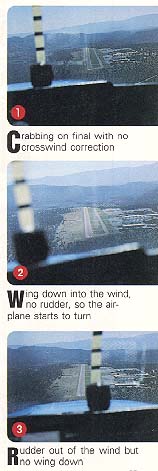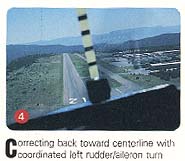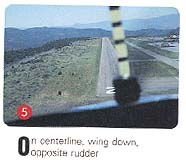
CROSSWINDS!!

To put it in a very small nutshell: To learn to do good crosswind landings, just get out and do a bunch of crosswind landings. Don't avoid the situation. Challenge it. In a lot of parts of the country, if you avoid crosswinds, you only get to fly about twice a year. Crosswinds only hurt you when you've been avoiding them and you inadvertently find yourself faced with a doozy. They can also hurt you, when you fail to recognize what constitutes a truly bad wind because you've been avoiding winds of all kinds and haven't learned to read them.
First a basic statement: wind, crossed or otherwise, is your friend. Unless the wind is 90°, at least part of it is down the nose and slowing you down. This works to your advantage because the energy of the airplane is a function of the square of the speed. Knock five knots off its ground speed and you've greatly lessened it's energy.
Crosswinds are also a subject that, in my humble opinion, are a) intellectualized too much, b) not instructed nearly enough, c) avoided entirely too much and d) intellectualized too much.
Another basic statement: It's not the wind that should concern you (within limits, of course), it's, first, the gust spread and then the variable direction, that should get your attention. A steady 60°, 15 knot crosswind is one thing and almost a joy to tame. A snappy little wind that is averaging 15 knots, but gusting five knots either side of that is another matter. Then, to make things even more interesting, let it snap from the nose to 60° and back. That'll keep you busy. And then there's the most dangerous of the bunch: wind that may be only 10 knots, but is whipping from in front of the wing to behind the wing. That has the effect of producing a shear type of situation that , if it occurs as the speed is bleeding off in initial flair, will plant you on the runway with almost no warning. Yes, there are some winds that, if not to be avoided, should at least to approached cautiously.
Another major factor concerning crosswinds is the airplane involved. Some airplanes, even really light ones, can handle more cross wind than others because they have good control effectiveness at slow speeds. A Cub or Super Cruiser, for instance, will surprise you in what they'll handle, if you stay right with them (you can land them in winds you can't safely taxi them in). Also heavier, faster airplanes can handle more wind simply because they're heavier and faster and the wind and gust spread constitute a smaller percentage of their touchdown speeds. Some airplanes have the best of both worlds in that they are not only heavier but also have good slow speed controllability (my record in the Pitts is 36 gusting to 46 at 60° to 80°: not an intentional situation, by the way, but not scary either).
Now, let's get back to the intellectualizing of crosswinds; Don't think about them! Do them! Far too many pilots look at the windsock on final and start thinking "let's see now, the wind's from the right so I put the right wing down, hold left rudder, etc., etc." Too much thought can screw you up on a crosswind landing.
Crosswind landings should be flown like video games in which the windshield is the CRT: if the picture you see in the windshield isn't what you want it to be, do what ever is necessary to make it right. Don't over-think it. Do it! If the airplane is drifting to the left, as seen in the windshield, do the natural thing. Lean into the wind by dropping that wing. Then, since part of any landing in any airplane, tailwheel or otherwise, should be to keep the tail lined up behind the nose, as the nose tries to move off the centerline, you use what ever rudder is necessary to keep it there, which is usually (surprise, surprise) opposite to the aileron you're holding. Don't think about it. Do it.
And then there's the question about when to put the correction in which divides aviation into two schools of thought. One school says wait until you're ready to flair, then get rid of the crab and pull the nose around straight and drop the wing while you're flaring. The other school says put in the cross control correction about a third of the way up final.
Both methods work. However, one big advantage to putting the correction in early while still on final is that it not only gets your head into the game and prepares you for what's about to come, but it also gives you an immediate understanding of that particular wind's characteristics. As you cross control to hold it on centerline, you see how hard you have to fight to hold it and can feel not only it's strength, but it's gust character, as well. Since the wind will almost always dissipate the closer you get to the ground, you'll probably find yourself easing out of some of the correction, as you get into ground effect.
If you follow the crank-it-in-at-the-last-minute school of thought, it doesn't give you much time to see what's going on at the last minute and it's easy to get a little overwhelmed. If you're a high timer, this is probably the way you land and that's okay. But, if you're a high timer, you probably aren't reading this anyway.
There is one other school of thought that, to put it bluntly, stinks. This school says to fly the airplane right into flair still in the crab, then kick it around straight with rudder only just before it touches. Boy, does that stink! Whew! In the first place, the second you start to pull the nose out of the wind with rudder without dropping the wing, the airplane is going to start drifting sideways, even if you do it at the last second. It's a physical impossibility in that situation not to touch down with the airplane moving at least a little bit sideways. Yes, a nosewheel airplane will sort out the situation after it hits, but it doesn't like it. That's the same logic that leads pilots into just planting the airplane on crooked knowing the gear geometry will straighten the airplane out. That sends shivers up the spine just thinking about it! If you're going to go to all the effort of learning to fly, why not do it right?
The pictures that accompany this text were shot in an effort to graphically illustrate what happens in different control situations and how it looks from the cockpit. Just try to use your imagination, okay?
 One
One
Crabbing on final with no crosswind correction
Don't start trying to use a cross control correction too far out
as the wind can be variable. Also, by setting up what ever crab
is needed it gives a concrete indication which direction the wind
is from and how strong it is. It also sets the airplane up in
a pronounced situation in which it is obvious what's wrong with
it: the nose is off to the left so it's going to take right rudder
to put it where it should be. That's a no brainer to figure out.
Two
Wing down into the wind, no rudder, so the airplane starts
to turn
This is a demonstration, remember, not the correct technique.
By putting the wing down into the wind without opposite rudder,
the airplane starts to turn off centerline and take us somewhere
we don't want to go. The obvious solution; use rudder to keep
the nose where we want it.
Three
Rudder Out of the Wind, but No wing down
Okay, so we're being hokey, but trying to prove a point. With
the wings level and some rudder out of the wind to pull the nose
straight, the airplane moves out of the wind and passes centerline
quickly. In fact, in this kind of situation, not only will the
airplane eagerly let the wind move it off centerline, but the
down rudder will also cause a roll to the right even though the
ailerons are neutral, greatly aggravating the wind's tendency
to move the airplane off centerline.
 Four
Four
Correcting back towards centerline with coordinated left
rudder/aileron turn
Overshooting centerline is never a good situation and corrections
back should be handled gingerly so as not to overshoot again.
They should also be made in coordinated movements, not jerking
it back towards centerline with the rudder only. Just ease it
back onto centerline and be prepared to hold the bank angle when
you cross control upon hitting centerline.
 Five
Five
On Centerline, wing down, opposite rudder
When you hit centerline hold in just enough aileron to keep the
airplane from moving off the centerline. That will probably cause
the nose to try and come into the wind which would re-establish
the original crab, if you let it. However, when we see the nose
trying to turn into the wind, we pressure opposite rudder. How
much? Who knows? It's different every time. Just use the video
screen concept and put in just as much rudder as you need to keep
the nose straight while using as much aileron as is necessary
to keep the airplane from drifting right. Don't think about it
too much. Just do what your eyes are telling you is needed.
The video screen concept is your guide throughout flair. Don't try to out guess the wind by holding in an amount of correction you think it will need rather than just giving it what it is telling you it needs. Quite often pilots correct for a wind that either isn't there or they hold in too much correction during the flair, rather than noticing the wind has lessened and they are drifting up-wind. Keep your eyes on the video screen that is the windshield. If the airplane is moving left or right, stop it. Just lean into it. If the nose isn't directly in front of you, put it directly in front of you, regardless of which rudder is needed.
Oh, by the way; If I didn't mention it, don't think about it too much. Just do it.